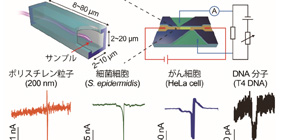
Current sensing system with highest sensitivity developed
As part of a research and development program led by Program Manager MIYATA Reiko under the Impulsing Paradigm Change through Disruptive Technologies Program (ImPACT) sponsored by the Council for Science, Technology and Innovation (CSTI), a group of researchers led by Professor BABA Yoshinobu, Assistant Professor YASUI Takao, and Researcher YASAKI Hirotoshi at the Graduate School of Engineering, Nagoya University, in a joint research project with Professor YANAGIDA Takeshi at the Institute for Materials Chemistry and Engineering, Kyushu University and Specially Appointed Professor KAWAI Tomoji at The Institute of Scientific and Industrial Research, Osaka University, developed a highly sensitive current sensing system, enabling measurements of currents passing through microparticles, microorganisms, and DNA molecules with high sensitivity.
Ionic current sensing systems that can provide electrical signals with information on the size of microparticles has attracted attention in recent years as compact measurement systems to efficiently measure sizes of substances in various fields. However, as conventional ionic current sensing systems have a limit on detectable size of samples, the size of the measurement part had to be changed according to the size of a sample. Because of this inherent limitation to the detectable particle volume, it was difficult to measure various-sized microparticles, microorganisms, and DNA molecules using a single size-sensing part.
Increasing the applied voltage increases the signal amplitude value; however, in conventional ionic current measurements, the background ionic current simultaneously increased with increasing the applied voltage, so increasing the applied voltage was not in the options. A new measurement technology to achieve both applying high voltage and suppressing background current has been sought after.
This research group tried to increase the applied voltage in the ionic current sensing system with a large sensing part. They developed an ionic current sensing system using a microfluidic bridge circuit, verifying that it was possible to suppress the background ionic current generated when applying high voltage to this sensing system from the µA level to the pA level. With this current sensing system, this group also succeeded in detecting microparticles, microorganisms, and DNA molecules in a single size-sensing chip. In addition, they succeeded in measuring nanoparticles using a microscale long pore structure.
The development of this technique will allow for easy detection of a trace of particulate matter (PM) 2.5, bio-aerosol, pathogens, pathogenic viruses, and DNA molecules, which will lead to the development of measurement systems for safe and secure society in the fields of environment measurement devices, bioscience research, and tailored individualized medicines. It is hoped that the development of this technique in the fields of basic medicine and molecular biology will contribute to their further advancement.
Abstract
Measuring ionic currents passing through nano- or micropores has shown great promise for the electrical discrimination of various biomolecules, cells, bacteria, and viruses. However, conventional measurements have shown there is an inherent limitation to the detectable particle volume (1% of the pore volume), which critically hinders applications to real mixtures of biomolecule samples with a wide size range of suspended particles. Here we propose a rational methodology that can detect samples with the detectable particle volume of 0.01% of the pore volume by measuring a transient current generated from the potential differences in a microfluidic bridge circuit. Our method substantially suppresses the background ionic current from the μA level to the pA level, which essentially lowers the detectable particle volume limit even for relatively large pore structures. Indeed, utilizing a microscale long pore structure (volume of 5.6 × 10 4 aL; height and width of 2.0 × 2.0 μm; length of 14 μm), we successfully detected various samples including polystyrene nanoparticles (volume: 4 aL), bacteria, cancer cells, and DNA molecules. Our method will expand the applicability of ionic current sensing systems for various mixed biomolecule samples with a wide size range, which have been difficult to measure by previously existing pore technologies.
Figure 1
To learn more about this research, please view the full research report entitled “ Substantial Expansion of Detectable Size Range in Ionic Current Sensingthrough Pores by Using a Microfluidic Bridge Circuit ” at this page of the Journal of the American Chemical Society website.
Related link

